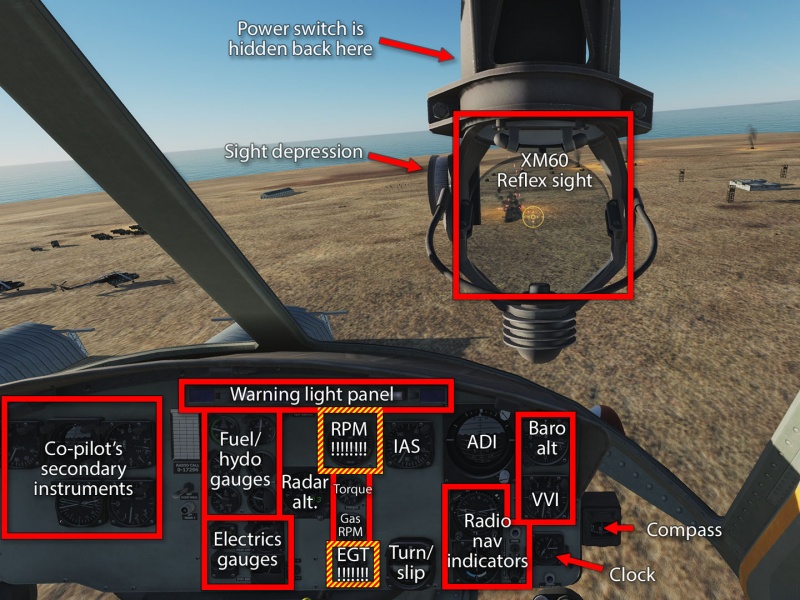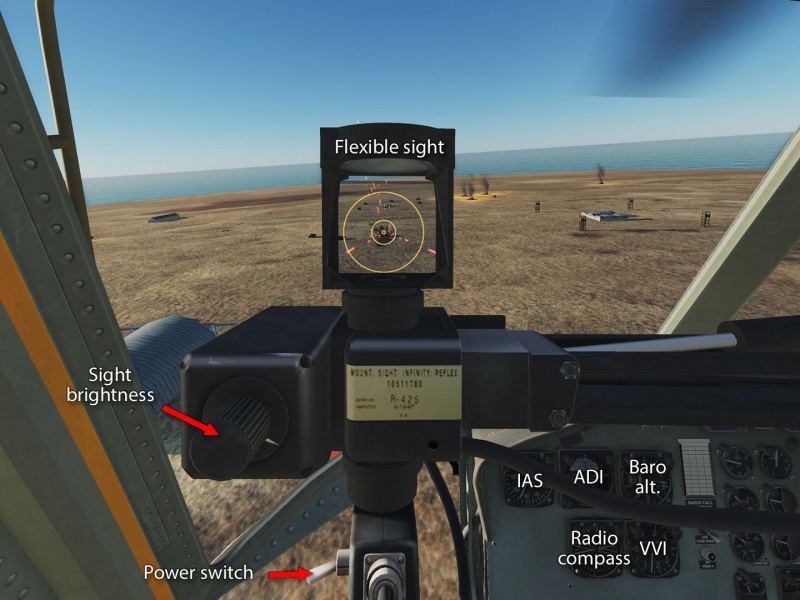UH-1H Huey
If the Huey needs any introduction, then just GTFO. It may technically be the “Iroquois” but ever since its initial and temporary HU-1 designation was first used, it has been known to everyone by the Huey monicker. The only thing more familiar than the name is its sound, which has become the universal shorthand for “helicopter noise” irrespective of what any given helo might actually sound like.
In DCS World, the UH-1H serves in role of acting as troop transport, cargo slinging platform, ground-support gunship, and general showing-off-your-skillz platform. It is by no means difficult to fly, as helicopters go, but it is the most direct and pilot-dependent way of doing so. Aside from some trimming and engine fine-tuning, there are no pilot aids to keep it straight and level, nor any hidden engine resources to keep the pilot out of trouble. Indeed, with version 2.5, long after the module's introduction, engine heating was added to the simulation, and suddenly sim pilots started to fall out of the sky in unprecedented numbers as their attempts to save themselves using engine power would instead just shred the engine completely.
Features
The UH-1H module offers:
- No multicrew, unfortunately, even though it is the module that would benefit from it the most, by far, instead you get:
- A co-pilot that can take over the controls for you.
- AI crew that will occasionally actually make a difference.
- The ability to switch between all four crew positions — fire the door guns while the AI holds a neat(?) orbit for you.
- Various rockets and machine guns to light up the countryside (quite literally in the case of illumination rockets).
- Front-facing miniguns that can be aimed directly using the co-pilot's flexible sight.
- Reasonably good night-flying capabilities, using pilot NVG:s and night lighting.
- No way of playing Wagner at high volume.
Comes with the built-in campaign UN Pilot.
Flying the UH-1H
The UH-1H is a very direct yet very smooth affair — it responds quickly enough to cyclical input to be crisp, but slowly enough to not be jittery. It does not have the beefiest of engines so the collective may feel a bit sluggish at times, but it nevertheless generates a comfy cushion of air to glide around on.
Treat it well and it will reward you with a joyous flying experience; treat it badly, and you will fall out of the sky, possibly while on fire. “Treating it badly” generally comes down to not watching two critically important dials: the engine and rotor tachometer, and the EGT gauge. Let the rotor RPM get too low, and you will fall out of the sky. Let the rotor and engine RPM desync, and you will fall out of the sky. Let the EGT get too high for too long, and you will destroy the engine, catch fire, and fall out of the sky. All helicopters can be challenging to fly due to the backwards nature of how throttle and stick operate compared to a fixed-wing aircraft, but the actual challenge in the Huey is to stay flying through the entire range of manoeuvres without ever letting any of those issues develop.
In particular, you will often find yourself wanting a bit more lift, at which point you might instinctively try to pull on the collective. The problem is that doing so too quickly can create the RPM desync; doing it solely to create lift will make the RPM drop; and doing it at all causes a rise in EGT. So the trick to not falling out of the sky is to learn how to build and lose altitude very gradually and to let translational lift do most of the work for you. That only leaves the slight issue of maintaining lift while landing and hovering…
Managing your crew
If you only ever fly the UH-1H clean, there is very little reason to leave the pilot's seat. The moment you start hanging weapons on it, however, you will most likely want to make use of the extra crew stations, either directly, or by letting the AI crew members do the job for you. The interface for doing so is for most part described on the kneeboard. For a bit more immediate access to what is going on, you can turn on the AI monitoring panel using LWinH.
While it may be tempting to just leave them on free fire at all times, they will quickly waste their ammo on just about anything and not be very effective until you get into a good orbit. Also note that if you give the co-pilot any kind of weapons control, the pilot can no longer fire, and additionally, the co-pilot will only ever use the miniguns so you will have to not just set the co-pilot to hold fire, but also manually switch back to rockets if you want to use those.
While in either of the front seats, you can still control the Huey as normal, but if you ever go into the side gunner positions yourself, you will probably want to turn the autopilot on using LWinA, and to set it to either a level (LCtrlA) or orbiting (LAltA) flight pattern. Note that, while in the pilot seat, you always have full control but the autopilot takes over if you are in the co-pilot seat. While the AI may offer a more stable platform while you use the flexible sight, you have to remember to be quick to either switch out of the seat or turn the autopilot off if it is heading in a bad direction.
Cockpit overview
Getting into the air
Shooting something
Links and files
- Chuck's UH-1H guide.
- DCS: UH-1H Huey by Belsimtek in the DCS shop.
Related DCS modules
- Argo for UH-1H campaign.
More information
- Bell UH-1 Iroquois on wikpedia.
- UH-1 Iroquois (Huey) on globalsecurity.org
| DCS World | |
|---|---|
| Helicopter modules (full sim) |
Ka‑50 Black Shark 2 · Mi‑8MTV2 Magnificent Eight · Mi‑24P Hind · SA342L, M, Mistral, and Minigun Gazelle · UH‑1H Huey |







